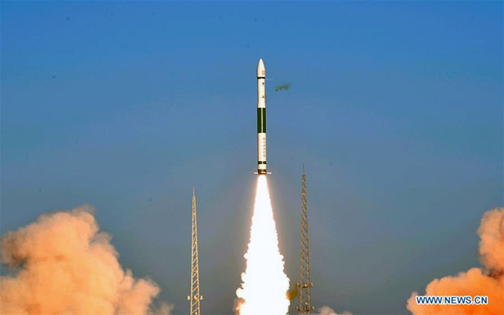
Two satellites for technological experiments are sent into space by a Kuaizhou-1A, or KZ-1A, carrier rocket from Jiuquan Satellite Launch Center in northwest China’s Gansu Province, on Aug. 31, 2019.
Photo is courtesy of Wang Jiangbo — Xinhua.
Two satellites for technological experiments were sent into space by a Kuaizhou-1A, or KZ-1A, carrier rocket from the Jiuquan Satellite Launch Center in northwest China on Saturday, August 31.
The rocket blasted off at 7:41 a.m. and sent the two satellites into their planned orbit.
Kuaizhou-1A, meaning speedy vessel, is a low-cost, solid-fuel carrier rocket with high reliability and a short preparation period. The rocket, developed by a company under the China Aerospace Science and Industry Corporation, is mainly used to launch low-orbit smallsats.
This launch was the third mission of the KZ-1A rocket.
One of the newly launched satellites was developed by the Innovation Academy for Microsatellites of the Chinese Academy of Sciences (CAS), and will be used for microgravity technology experiments. This smallsat will conduct on-orbit experiments on ultra-high precision control and measurement technologies under microgravity conditions, according to the CAS. The technologies will lay a solid foundation for space science tasks and frontier basic science research, such as space-based gravitational wave detection and ultra-high precision inertial navigation, CAS said.
The other satellite, developed by Spacety Co., Ltd. (Changsha), a privately owned Chinese commercial space company, will be used to test solar sail technology. The microgravity technology experiment satellite belongs to the second phase of a space science program of the CAS. During the first phase, a series of space science satellites have been sent into space, including the DAMPE to search for dark matter, the world’s first quantum satellite and the HXMT, China’s first X-ray space telescope.
Over the coming three to four years, China plans to launch new space science satellites including the Gravitational Wave Electromagnetic Counterpart All-sky Monitor (GECAM), the Advanced Space-borne Solar Observatory (ASO-S), the Einstein-Probe (EP) and the Solar wind Magnetosphere Ionosphere Link Explorer (SMILE) to study gravitational waves, black holes, the relationship between the solar system and humanity, and the origin and evolution of the universe.
Article source: China.org.com

For all involved in the satellite and space industry and the various market segments that add value to these dynamic environments, the 2020 SmallSat Symposium is truly worth your consideration for attendance.
The SmallSat Symposium is hosted by Satnews Publishers which, since 1983, has been a provider of a satellite news, media and events. This information packed forum was created to enable you and your company to secure a larger portion of market share as well as to take part in the next stages of your company’s or organization’s growth.

The personal connections at the SmallSat Symposium enable attendees to network with established organizations, subject-matter experts as well as ‘New Space’ entrants.
The SmallSat Symposium will focus on new technologies and the business environment that is shaping the implementation of smallsat constellations, smallsat launchers, the challenges facing the smallsat developer and actors as well as the enormous benefits of these advanced technologies that will benefit our world.
This event assembles more than 100 diverse speakers, all of whom possess deep industry experience. Additionally, numerous opportunities exist to mingle and network with peers while enjoying exceptional, complimentary meals and refreshment breakfast.

